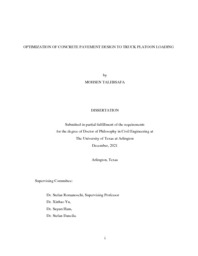
ATTENTION: The works hosted here are being migrated to a new repository that will consolidate resources, improve discoverability, and better show UTA's research impact on the global community. We will update authors as the migration progresses. Please see MavMatrix for more information.
Show simple item record
| dc.contributor.advisor | Romanoschi, Stefan | |
| dc.creator | Talebsafa, Mohsen | |
| dc.date.accessioned | 2023-06-28T14:51:38Z | |
| dc.date.available | 2023-06-28T14:51:38Z | |
| dc.date.created | 2021-12 | |
| dc.date.issued | 2021-12-16 | |
| dc.date.submitted | December 2021 | |
| dc.identifier.uri | http://hdl.handle.net/10106/31367 | |
| dc.description.abstract | Transportation is the major contributor toward economic growth and development. In the United States, more than 90% of commodities are transported through the roadway system. Due to the high demand for transportation of goods, there is a high demand in the road freight industry for innovative solutions, and new technologies to improve the sustainability and efficiency of transportation. Truck platooning is one of the most recent technologies with great potential to make road freight safer, cleaner, and more efficient. This technology uses connectivity technologies and
automated driving systems to interconnect two or more trucks in a convoy. These automation technologies provide unique characteristics to truck platooning traffic which leads to a different impact on pavement structures compared to normal traffic. The lateral position of trucks in real traffic is random, but it is generally assumed that this position is normally distributed across the lane. This variation in lateral position is called wheel wander which has a positive impact on the service life of pavements. However, platooning technology removes wheel wander and keeps the
trucks at a fixed distance from the edge of the lane. This channelized traffic leads to a higher accumulation of fatigue damage in the wheel path of the platoon. It cancels the positive effect of wheel wander on pavement life and significantly reduces the service life of the pavement.
This study aims to investigate several solutions to improve the performance of rigid pavements and extend their longevity to withstand against truck platooning traffic. To do so, Three-Dimensional Finite Element (3-D FE) modeling was implemented to model JPCP and CRCP structures and analyze pavement responses under truck platooning loading. Fatigue analysis was conducted to investigate possible performance improvement of various design considerations including increasing the thickness of the PCC layer, thickened PCC layer under the wheel path, increasing the size of dowel bars/rebars, and implementing larger diameter dowel bars/rebars
within the wheel path. In addition, normal traffic with wheel wander was simulated to investigate the performance of each design alternative under traffic with wheel wander. The results indicate that increasing the thickness of concrete slab significantly improves the fatigue performance of pavements under channelized traffic and traffic with normal wander. Although using larger size dowel bars/rebars under the wheel path slightly improves the fatigue performance of pavements under truck platooning traffic, the effectiveness of this measure reduces as the thickness of the slab increases. Also, it was observed that the relative improvement in fatigue performance is highly dependent on fatigue models used in the calculations. In addition, to determine the optimal design
alternative to withstand truck platooning a cost analysis based on the cost of materials was performed. It was found that increasing the size of dowel bars in JPCP is the most cost-effective measure since by 3% increase in the cost of construction, improves the fatigue performance by 44%. In CRCP structures, however, increasing the thickness of slab under the wheel path by 2.0 inches was found to be an optimal measure as it provides a 41% improvement of fatigue life only
with a 6% increase in the cost of materials. | |
| dc.format.mimetype | application/pdf | |
| dc.language.iso | en_US | |
| dc.subject | Truck Platooning | |
| dc.subject | Wheel Wander | |
| dc.subject | Concrete pavement | |
| dc.subject | Fatigue Damage | |
| dc.title | OPTIMIZATION OF CONCRETE PAVEMENT DESIGN TO TRUCK PLATOON LOADING | |
| dc.type | Thesis | |
| dc.date.updated | 2023-06-28T14:51:39Z | |
| thesis.degree.department | Civil Engineering | |
| thesis.degree.grantor | The University of Texas at Arlington | |
| thesis.degree.level | Doctoral | |
| thesis.degree.name | Doctor of Philosophy in Civil Engineering | |
| dc.type.material | text | |
| dc.creator.orcid | 0000-0002-5116-561X | |
Files in this item
- Name:
- TALEBSAFA-DISSERTATION-2021.pdf
- Size:
- 4.467Mb
- Format:
- PDF
This item appears in the following Collection(s)
Show simple item record


